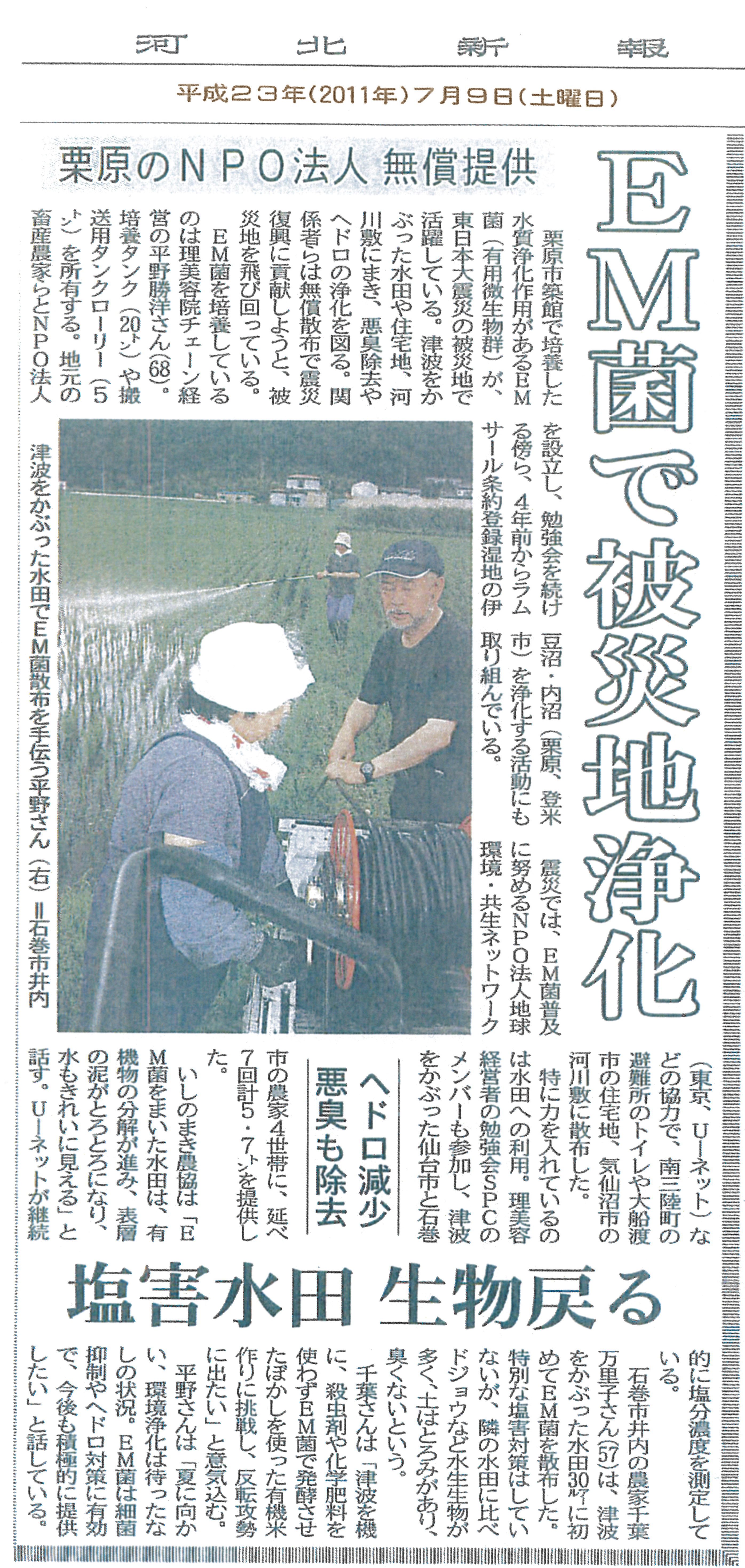
No. 47: EM Effects on Saline Contaminated Fields in Miyagi Prefecture
I talked about elimination of saline and sludge in rice fields in my previous messages Nos.39, 41, and 43. Only a few farmers were willing to try my way. With active cooperation of JA (Japan Agriculture) Miyagi and JA Ishinomaki, U-net (a not-for-profit organization) has launched on experimentation.
Farming experts and the Ministry of Agriculture, Forestry, and Fisheries concluded that no crop would grow for 3-4 years after being covered by sea water and that huge cost would incur to remove sludge and saline from the fields, while I recommended EMA that enables farming without removing sludge and saline. There is a big difference between us.
If the problem of sludge and saline contamination can be solved as easily as I recommend, and the voluntary assistance is offered by U-net, it was too good for JA Miyagi and JA Ishinomaki not to try in this emergency situation. It could open a door to recovery with their limited resources and in a reasonable time frame.
Mr. Suzuki of Suzuki Organic Farm was the first who contacted me immediately after the Tsunami in March. He had been using EM successfully and wanted to know how to use EM to clean his rice paddies and get ready for rice planting in May. He knew that all he needed was water, but water supply to rice paddies was halted in accordance with the policy set by the national and the prefectural governments. He could not plant rice without water.
He planned to draw water from a nearby stream that was 300m away, but found out that the water from the stream was contaminated and not sufficient in volume. He decided to dig a well to secure enough water to farm 1.5ha rice paddy to conduct a joint experiment with U-net.
I recommended to Mr. Suzuki to apply EM to the water-filled paddies, plow shallow, and after a couple of weeks when no foul odor is detected, transplant young rice seedling. Mr. Suzuki, however, conducted the recommended procedure twice and each time he drained water, which insured the better results.
Mr. Suzuki sells his products directly to his customers and needed to keep his professional obligation to his customers. In order to insure the successful harvest, he conducted the recommended procedures twice.

JA Ishinomaki, however, followed my recommendation and applied EM only once with a shallow plow before transplanting rice seedling, Mr. Suzuki told me later that he stood by to watch the procedure and felt rather anxious if it would really work. They had an outbreak of rice water weevils, and additional EM sprays were required. But, a good harvest is now expected as reported in Kohoku Shimpo (dated 9th of July).
The experiments are at the middle point toward completion, but you can easily observe that the ecology of rice field is coming back after EM application that eliminated foul odor and converted sludge to soil nourishment. As I have insisted, “it is better to transplant rice because Japan has enough rainfall in rainy season (June) that washes away sludge and saline” even for the rice paddies without EM application. However, without EM application, foul odor remains (i.e., harmful gasses of methane and hydrogen sulfide hamper growth). It is not too late to insure at least an average harvest by applying 50-100L EMA per 10a in August.
It is a common knowledge among the rice growers that the rice field with foul odor means bad tasting rice. In order to prevent growth hindrance and to harvest quality rice, EM should be applied. Not only this year but also the next year’s harvest will be insured.
Kohoku Shimpo reported: Mr. Chiba said, “Tsunami gave me an opportunity to use EM rather than to continue using insecticides and chemical fertilizers. I like to take advantage of this occasion to start on EM organic rice farming.” I believe that he is the future rice grower in Ishinomaki and an encouragement to the rice farmers in the Tsunami affected areas. I hope that JA Ishinomaki will use this experiment wisely and effectively to enhance their cause.
記事一覧へ
| 